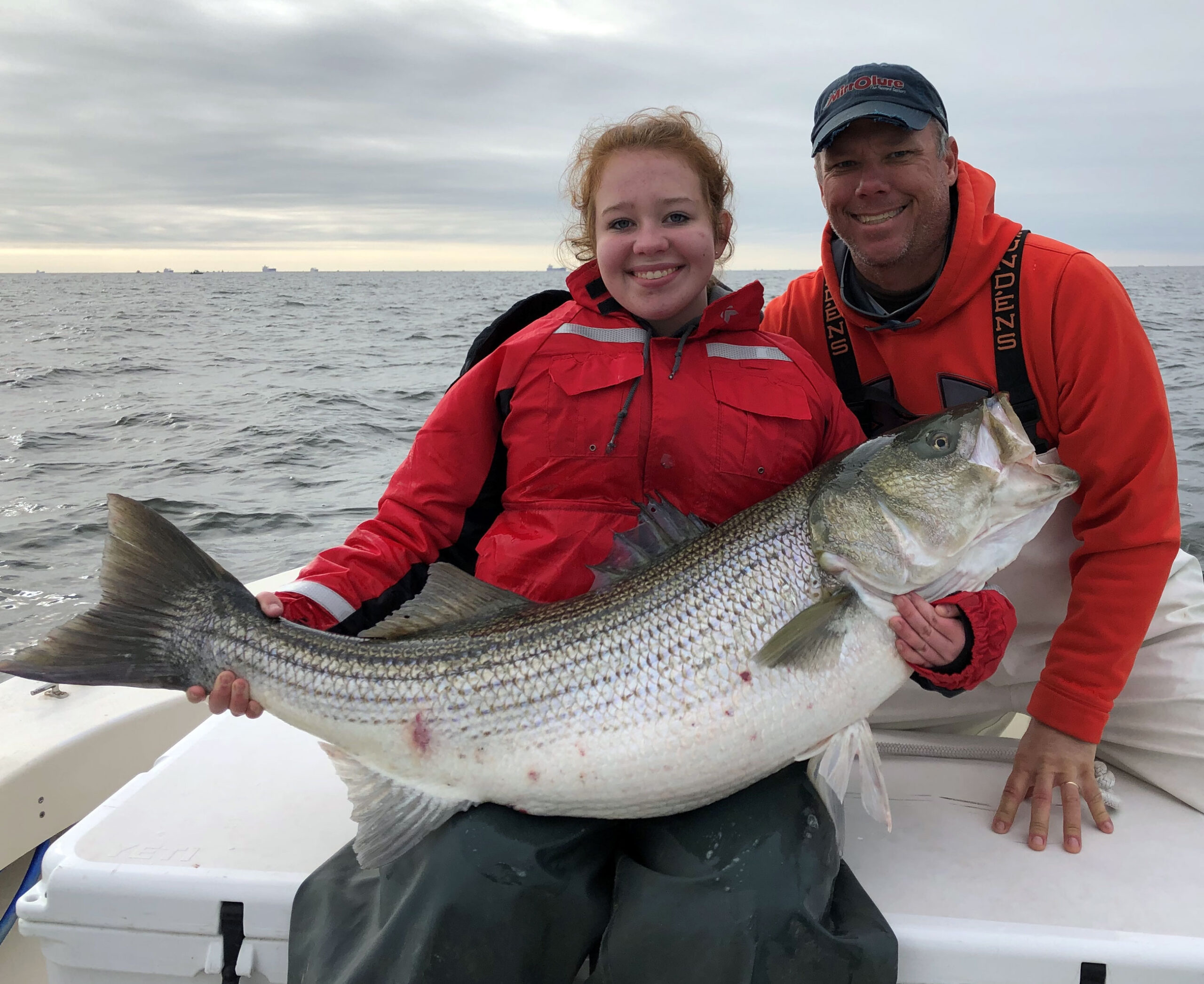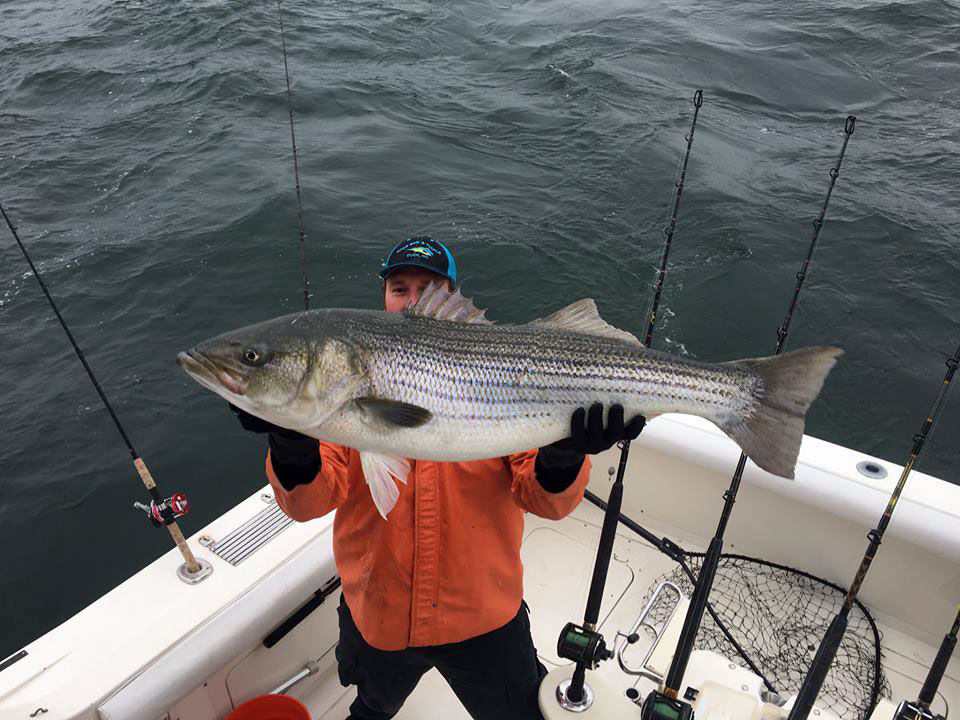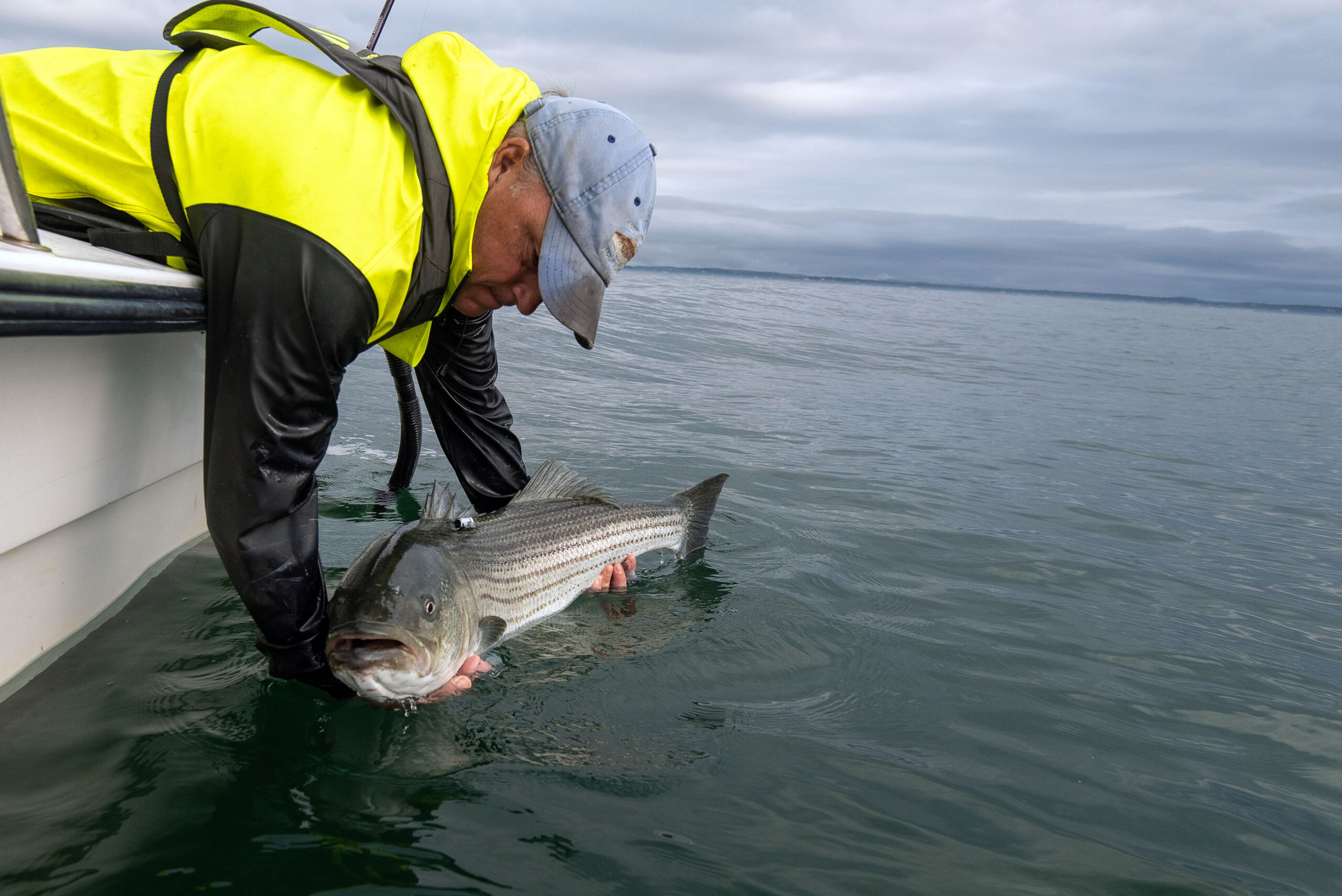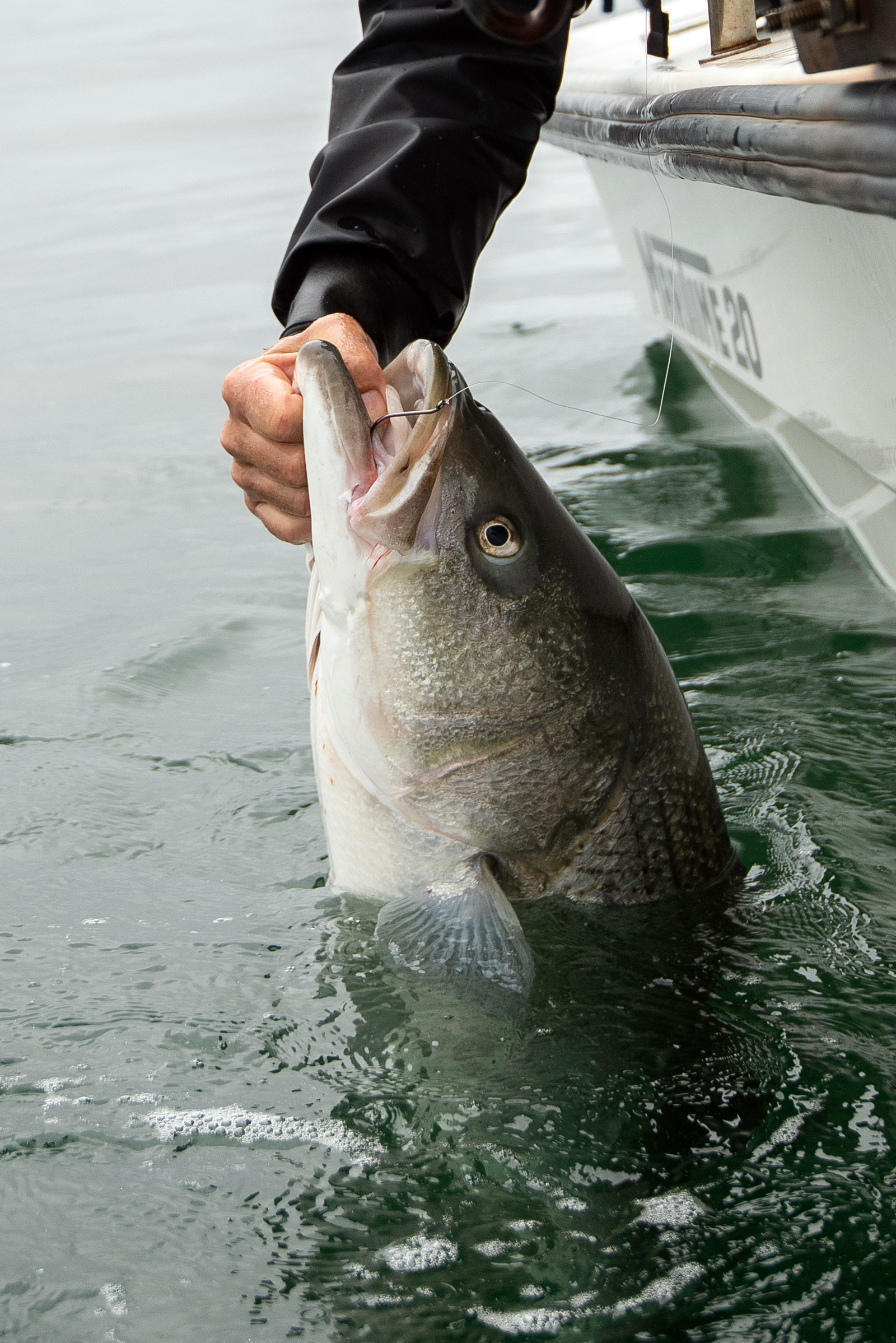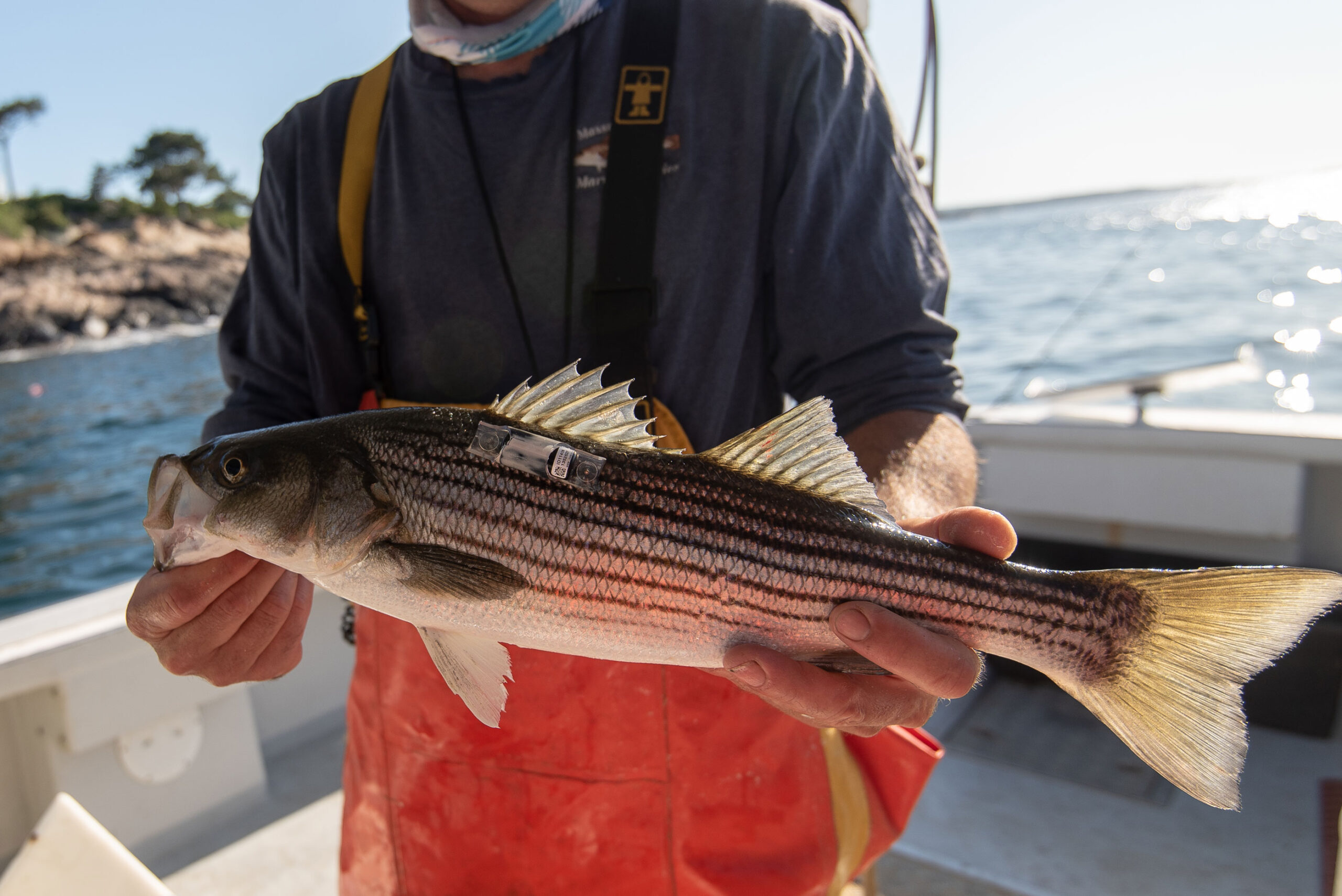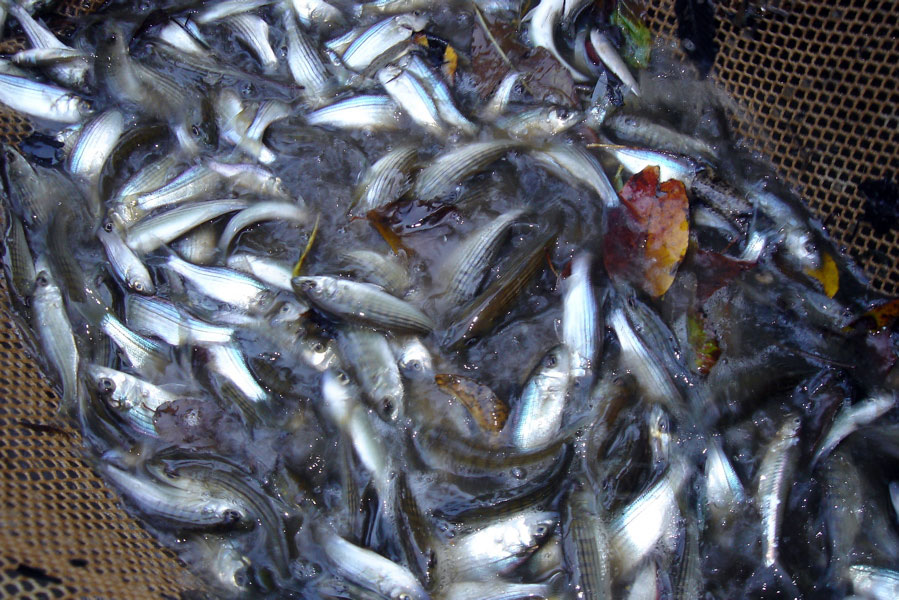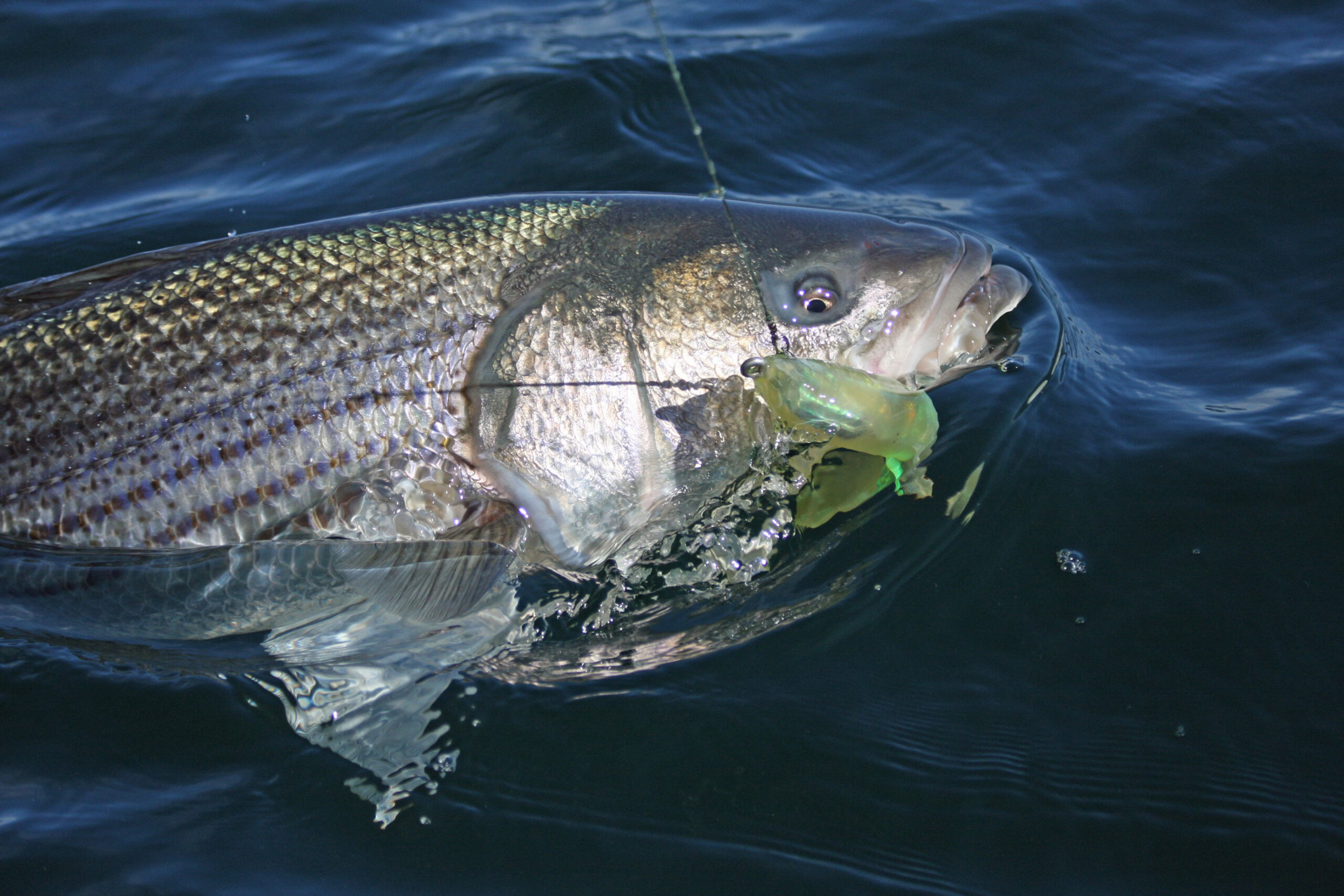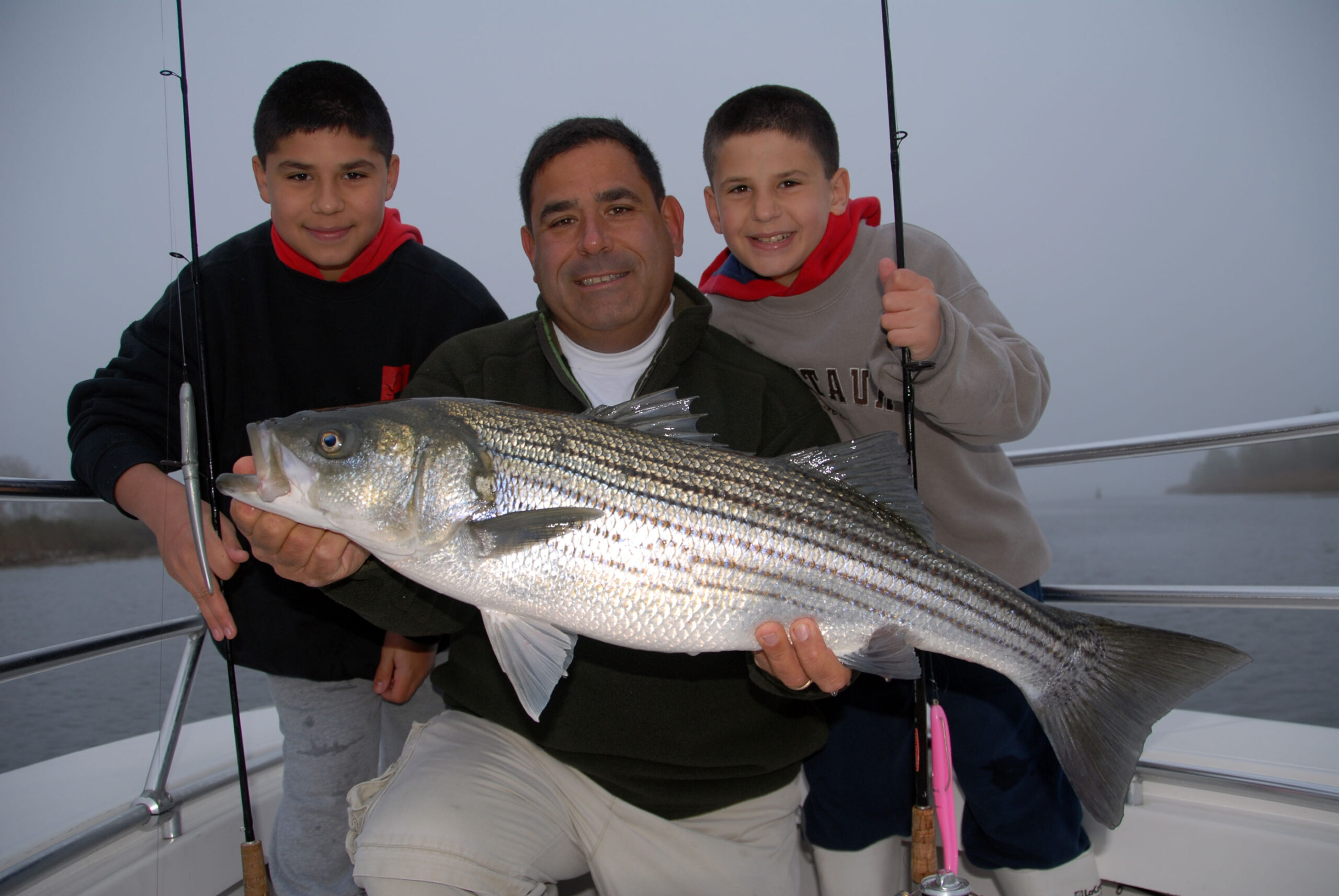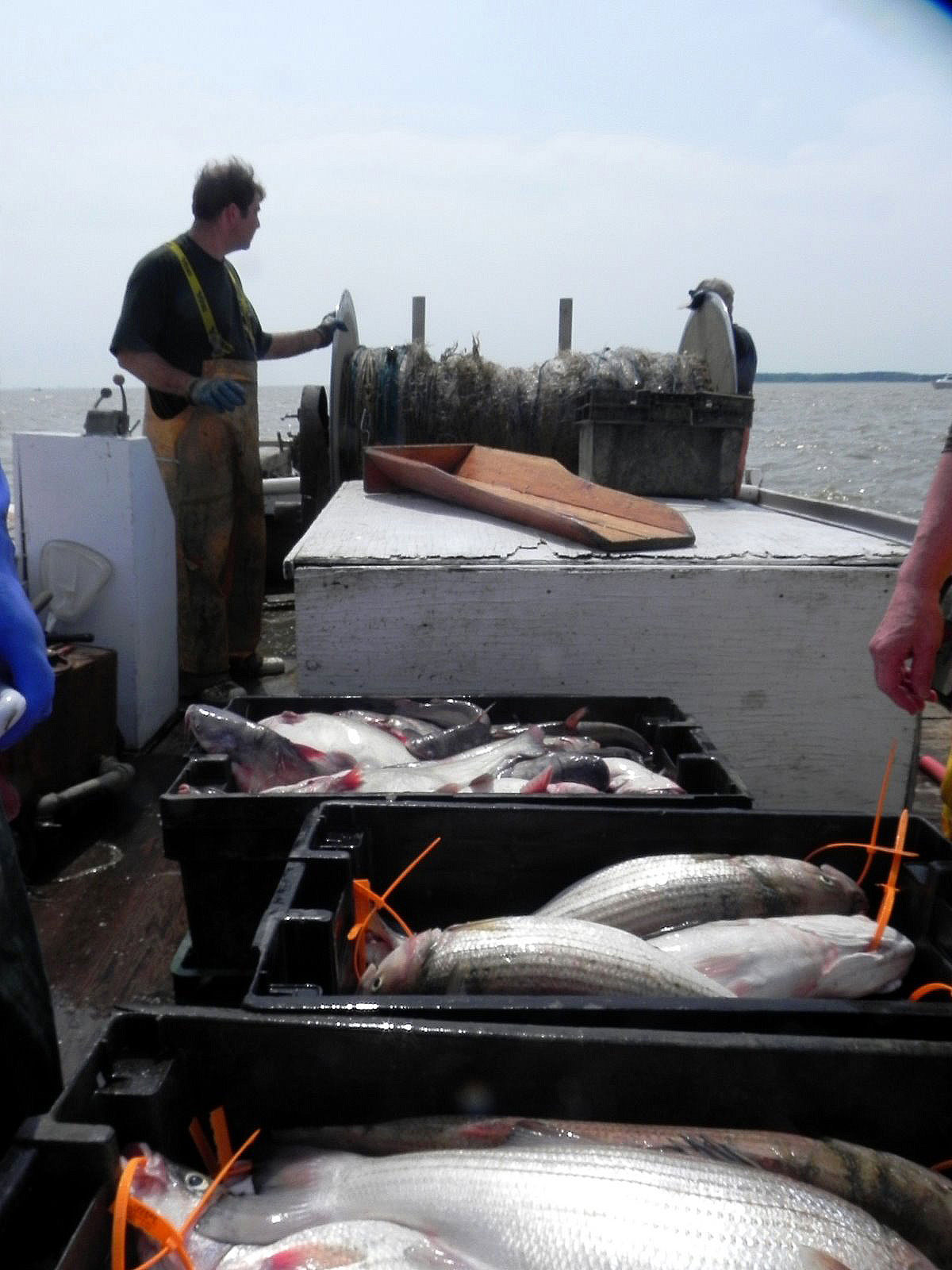Atlantic Striped Bass
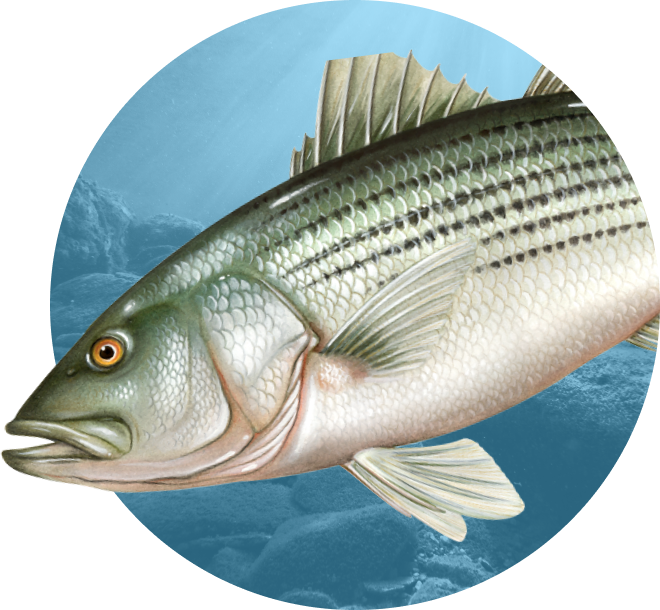
Latest News and Resources
-
2026 Winter Meeting Preliminary Agenda
-
Atlantic Striped Bass Addendum III to Amendment 7 – October 2025
-
Atlantic Striped Bass Commercial Tagging Ten-Year Review Report – 2025
-
Atlantic Striped Bass Management Board Annual Meeting Presentations — October 2025
-
2025 Annual Meeting Summary — October 2025
-

Population Abundance
Overfished
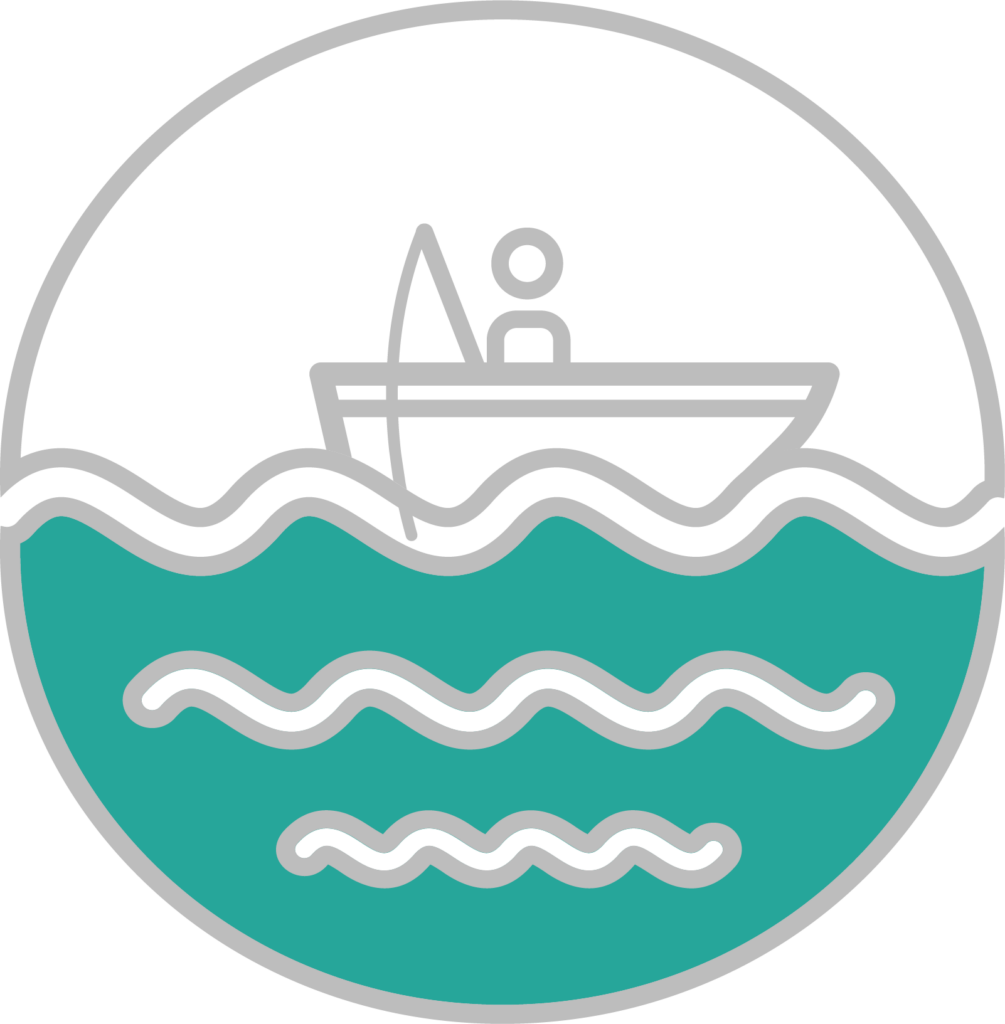
Fishing Mortality
Overfishing not occurring
Current Status
Stock status based on 2024 assessment update. Restrictive measures implemented in 2020 and 2024 to reduce fishing mortality and support stock rebuilding.
Meeting Calendar
Next Meeting
-
Recent Management Actions
Action
Status
Contacts
- Emilie Franke, FMP Coordinator (EFranke@asmfc.org)
- Management Board, Chris Batsavage, Chair
- Technical Committee, Tyler Grabowski, Chair
- Advisory Panel, Eleanor Bochenek, Chair
Species Information
Atlantic striped bass are a sought-after estuarine species inhabiting coastal waters from Florida to Canada, known for their impressive size and seasonal migrations between estuaries and the open ocean. Managed under the Interstate Fishery Management Plan, striped bass support both vibrant recreational and commercial fisheries through adaptive measures such as quota systems, size limits, and bag limits. Recent stock assessments reveal that while fishing mortality remains below threshold levels, the species is still overfished, leading the Commission to implement enhanced management strategies aimed at rebuilding populations and ensuring the long-term health of this iconic fishery.
Management
Currently, Atlantic striped bass is managed under Amendment 7 to the Interstate Fishery Management Plan (FMP, 2022), which consolidates Amendment 6 and its associated addenda into a single document. Amendment 7 establishes new requirements for the following components of the FMP: management triggers, conservation equivalency, additional measures to address recreational release mortality, and the stock rebuilding plan. This Amendment builds upon the Addendum VI to Amendment 6 action to address overfishing and initiate rebuilding in response to the overfished finding from the last stock assessment, requiring the Board to rebuild the stock by 2029. Amendment 7 strengthens the Commission’s ability to reach the rebuilding goal by implementing a more conservative recruitment trigger, providing more formal guidance around uncertainty in the conservation equivalency process, and implementing measures intended to increase the chance of survival after a striped bass is released alive in the recreational fishery. All provisions of Amendment 7 are effective May 5, 2022 except for gear restrictions. States were required to implement new gear restrictions by January 1, 2023.
Amendment 7 also maintains the same recreational and commercial measures specified in Addendum VI to Amendment 6, which were implemented in 2020. As such, all approved Addendum VI conservation equivalency programs and state implementation plans are maintained until such measures are changed in the future.
Addendum I to Amendment 7 was approved in May 2023 to allow for voluntary ocean commercial quota transfers contingent on stock status. When the stock is overfished, no quota transfers will be allowed. When the stock is not overfished, the Board can decide every one to two years whether it will allow voluntary transfers of ocean commercial quota. The Board can also set criteria for allowable transfers, including a limit on how much and when quota can be transferred in a given year, and the eligibility of state to request a transfer based on its landings.
In May 2023, the Board approved an emergency action to change the recreational size limit in response to the unprecedented magnitude of 2022 recreational harvest, which was nearly double that of 2021, and new stock rebuilding projections, which estimated the probability of the spawning stock rebuilding to its biomass target by 2029 drops from 97% under the lower 2021 fishing mortality rate to less than 15% if the higher 2022 fishing mortality rate continues each year.
The Board established the emergency 31-inch maximum size limit for recreational fisheries to reduce harvest of the strong 2015-year class. The emergency action was effective until May 1 2024, at which point it was replaced by Addendum II to Amendment 7 measures, described below.
Addendum II to Amendment 7 was approved in January 2024 to reduce fishing mortality in 2024 and support stock rebuilding. For the ocean recreational fishery, the Addendum implements a 28” to 31” slot limit, 1-fish bag limit, and maintains 2022 season dates for all fishery participants; this maintains the same ocean recreational measures adopted under the 2023 emergency action. For the Chesapeake Bay recreational fishery, the Addendum implements a 19” to 24” slot limit, 1-fish bag limit, and maintains 2022 season dates for all fishery participants. For the commercial fishery, the Addendum reduces commercial quotas by 7% in both the ocean and Chesapeake Bay. To address concerns about recreational filleting allowances and compliance with recreational size limits, the Addendum establishes two requirements for states that authorize filleting of striped bass: racks must be retained and possession limited to no more than two fillets per legal fish. Finally, to enable an expedited response process to upcoming stock assessments, the Addendum establishes a mechanism allowing the Board to respond to a stock assessment via Board action if the stock is not projected to rebuild by 2029. All Addendum II measures were required to be implemented by the states no later than May 1, 2024.
Addendum III to Amendment 7 was approved in October 2025 to modify requirements for commercial tagging programs, define a standard method of measuring total length for size regulations, and allows Maryland to change its Chesapeake Bay recreational season baseline if the state so chooses. For commercial tagging, the Addendum requires commercially-harvested striped bass to be tagged by the first point of landing. The three states that will need to switch their tagging program from point of sale to point of landing have until the end of 2028 to make that change. For measuring total length, the Addendum specifies that when measuring total length of a striped bass it must be a straight-line measurement with upper and lower fork of the tail squeezed together. This definition applies to both sectors. States that do not have the new definition in place already have until January 1, 2027 to make changes to their state regulations. For Maryland’s Chesapeake Bay recreational fishery, the Board approved Maryland’s ability to change its recreational season baseline (i.e., the timing, type, and duration of striped bass closures throughout the year) if the state so chooses. Maryland will notify the Board of its decision by December 31, 2025.
The Board did consider a 12% reduction in fishery removals through Draft Addendum III. After lengthy deliberation and considering public comments that were sharply divided on the issue, the Board decided to maintain status quo and not move forward with the reduction. The Board noted the severe economic consequences of the proposed reduction, the low fishing mortality rate in 2024, and preliminary indications of lower catch in 2025. However, the Board continued to express concern about the 7 consecutive years of low recruitment in Chesapeake Bay and the impact on the stock as those weak year-classes become the majority of the spawning stock biomass after 2029. To address this, the Board approved the establishment of a Work Group to consider these upcoming stock and management challenges beyond 2029. The Board will discuss the specific tasks and timing of this Work Group at subsequent Board meetings.
Management History
Increased fishing pressure in the 1970s, coupled with degradation and loss of habitat, led to stock collapse and stimulated the development of a cooperative interstate fisheries management plan (FMP). While a notable first step, the first FMP (1981) and Amendments 1 and 2 to the plan (1984) only provided recommendations on how to manage the resource. States could take voluntary actions under these management plans but there was no statutory requirement that ensured unified management actions by all the involved states. The passage of the Atlantic Striped Bass Conservation Act in 1984 (Striped Bass Act) changed this by requiring the states, through the Commission, to develop and implement management plans that included mandatory conservation measures. Amendment 3 (1985) was the first plan under the Striped Bass Act with such measures, including regulations to protect the 1982 year class, the first modestly-sized cohort for nearly a decade. Some states elected for an even more conservative approach and imposed a total moratorium to protect the 1982 year class. The Amendment contained a mechanism to relax fishery regulations based on a juvenile abundance index. The mechanism was triggered with the recruitment of the 1989 year class and led to the implementation of Amendment 4 (1989), which aimed to rebuild the resource rather than maximize yield. In 1995, with adoption of Amendment 5, the Commission declared Atlantic coastal striped bass stocks fully recovered.
Amendment 6 (2003) introduced a new set of biological reference points based on female spawning stock biomass (SSB), and a suite of management triggers based on the reference points. It also restored the commercial quota for the ocean fishery to 100% of average landings during the 1972-1979 historical period, and recreational fisheries were constrained by a 2-fish bag limit and a minimum size limit of 28 inches, except for the Chesapeake Bay fisheries, Albemarle-Roanoke (A/R) fisheries, and fisheries with approved conservation equivalency proposals. From 2007 to 2014, a series of four Addenda (I-IV) to Amendment 6 were implemented. These addenda addressed a range of issues, including implementation of a bycatch monitoring program, modifying the definition of recruitment failure, implementation of a mandatory commercial harvest tagging program, and establishing one set of F reference points for the coastal migratory population in all management areas. Addendum IV (2014) also formally deferred management of the A/R stock to the State of North Carolina, under the auspices of the Commission, since the A/R stock was deemed to contribute minimally to the coastal migratory population.
In 2019, a new benchmark assessment which used updated recreational catch estimates, changed our understanding of stock status. The benchmark assessment found the stock to be overfished and experiencing overfishing. As a result, Addendum VI to Amendment 6 was initiated to end overfishing, and bring F to the target level in 2020. Specifically, the Addendum reduced all state commercial quotas by 18%, and implemented a 1-fish bag limit and a 28” to less than 35” recreational slot limit for ocean fisheries and a 1-fish bag limit and an 18” minimum size limit for Chesapeake Bay recreational fisheries. These measures were implemented in 2020 and designed to achieve at least an 18% reduction in total removals at the coastwide level. The Addendum maintained flexibility for states to pursue alternative regulations through conservation equivalency and the Board approved CE programs for multiple states. Since catch and release practices contribute significantly to overall fishing mortality, the Addendum mandated the use of circle hooks when fishing with bait to reduce release mortality in recreational striped bass fisheries.
As it considered its actions under Addendum VI, the Management Board also discussed the development of a new Amendment to the FMP, one that reflected our understanding of the resource and the fisheries that depend on it. This led to the development and approval of Amendment 7 in 2022.
Stock Status
On a regular basis, female spawning stock biomass (SSB) and fishing mortality rate (F) are estimated and compared to target and threshold levels (i.e., biological reference points) in order to assess the status of the stock. The 1995 estimate of female SSB is currently used as the SSB threshold because many stock characteristics, such as an expanded age structure, were reached by this year, and this is also the year the stock was declared recovered.
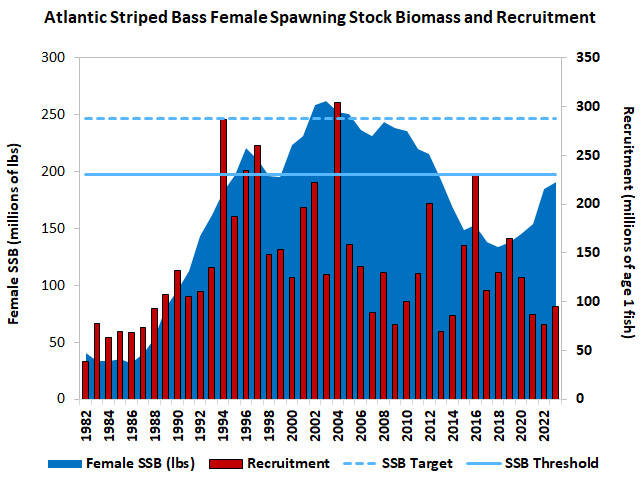
The female SSB target is equal to 125% female SSB threshold. The associated F threshold and target are calculated to achieve the respective SSB reference points in the long term.
In November 2024, the Board reviewed the results of the 2024 Atlantic Striped Bass Stock Assessment Update, which uses the same model from the approved, peer-reviewed 2018 Benchmark Stock Assessment. The accepted model is a forward projecting statistical catch-at-age model, which uses catch-at-age data and fishery-dependent data and fishery-independent survey indices to estimate annual population size, fishing mortality, and recruitment. The 2024 assessment indicated the resource is still overfished but not experiencing overfishing relative to the updated reference points. Female SSB in the terminal year (2023) was estimated at 191 million pounds, which is below the SSB threshold of 197 million pounds and below the SSB target of 247 million pounds. F in 2023 was estimated at 0.18, which is below the F threshold of 0.21 and above the F target of 0.17. The updated fishing mortality reference points took into account the period of low recruitment the stock has experienced in recent years.
The assessment also indicated a period of strong recruitment (numbers of age-1 fish entering the population) from 1994-2004, followed by a period of lower recruitment from 2005-2011 (although not as low as the early 1980s, which likely contributed to the decline in SSB in recent years). Recruitment of age-1 fish was above-average in 2012, 2015, 2016, and 2019 (corresponding to strong 2011, 2014, 2015, and 2018 year classes), but estimates of age-1 striped bass were below the long-term average for 7 of the last 10 years. Recruitment in 2023 was estimated at 95 million age-1 fish, below the time series average of 137 million fish.
A benchmark stock assessment for Atlantic striped bass is underway with expected completion in Spring 2027.
Commercial & Recreational Fisheries
In 2024, total Atlantic striped bass removals (commercial and recreational, including harvest, commercial discards and recreational release mortality) was estimated at 4.1 million fish, which is a 27% decrease from 2023 total removals. This 2024 decrease was primarily driven by a decrease in recreational removals, with commercial removals at a similar level as 2023. In 2024, the recreational sector accounted for about 85% of total removals by number of fish, and the commercial sector accounted for about 15%.
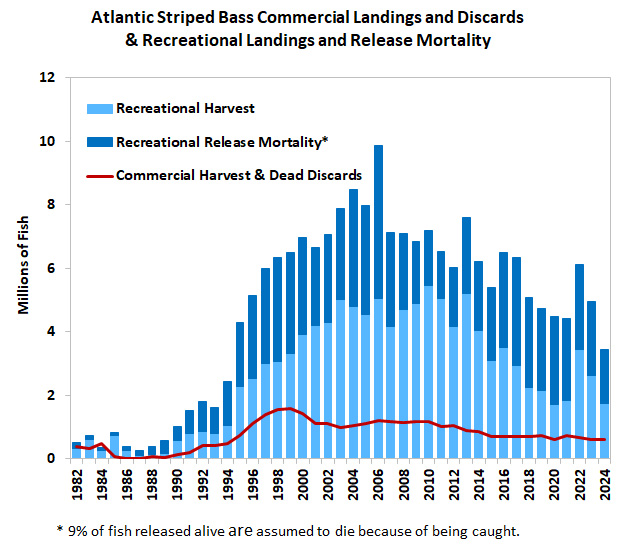
The commercial fishery is managed by a quota system resulting in relatively stable landings since 2004. There are two regional quotas; one for Chesapeake Bay and one for the ocean, which includes bays, inland rivers, and estuaries. The ocean quota is based on average landings during the 1970s and the Chesapeake Bay quota changed annually under a harvest control rule until implementation of a static quota in 2015 through Addendum IV. From 2004 to 2014, commercial landings averaged 6.8 million pounds (about 943,000 fish) per year. From 2015-2019, commercial landings decreased to an average of 4.7 million pounds (about 619,000 fish) due to implementation of Addendum IV. From 2020-2023, coastwide commercial landing decreased again to an average 4.1 million pounds (about 612,000 fish) due to further reduced quotas through Addendum VI. In 2024, commercial landings were 4.3 million pounds, a slight increase despite the Addendum II quota reduction. Commercial landings are consistently dominated by Chesapeake Bay fisheries, accounting for approximately 60% of total commercial landings by weight since 1990 (80% in terms of numbers of fish).
The recreational fishery is predominantly prosecuted as catch and release, meaning the majority of striped bass caught are released alive either due to angler preference or regulation (e.g., undersized, or the angler already harvested the daily bag limit). Since 1990, roughly 90% of total annual striped bass catch is released alive of which 9% are estimated to die as result of the fishing interaction (referred to as “release mortality” or “discard mortality”). In 2024, recreational anglers released alive an estimated 19.1 million fish, of which 1.7 million are assumed to have died.
The recreational fishery is predominantly prosecuted as catch and release, meaning the majority of striped bass caught are released alive either due to angler preference or regulation (e.g., undersized, or the angler already harvested the daily bag limit). Since 1990, roughly 90% of total annual striped bass catch is released alive of which 9% are estimated to die as result of the fishing interaction (referred to as “release mortality” or “discard mortality”). In 2024, recreational anglers released alive an estimated 19.1 million fish, of which 1.7 million are assumed to have died.
Please refer to the 2024 FMP Review for more details on annual fishery performance by state and sector.
Life History
Atlantic striped bass (Morone saxatilis) are an estuarine species that can be found from Florida to Canada, although the stocks that the Commission manages range from Maine to North Carolina. A long-lived species (at least up to 30 years of age), striped bass typically spend the majority of their adult life in coastal estuaries or the ocean, migrating north and south seasonally and ascending to rivers to spawn in the spring.
Mature females (age six and older) produce large quantities of eggs, which are fertilized by mature males (age two and older) as they are released into riverine spawning areas. While developing, the fertilized eggs drift with the downstream currents and eventually hatch into larvae. After their arrival in the nursery areas, located in river deltas and the inland portions of coastal sounds and estuaries, they mature into juveniles. They remain in coastal sounds and estuaries for two to four years and then join the coastal migratory population in the Atlantic Ocean. In the ocean, fish tend to move north during the summer and south during the winter. Important wintering grounds for the mixed stocks are located from offshore New Jersey to North Carolina. With warming water temperatures in the spring, the mature adult fish migrate to riverine spawning areas to complete their life cycle. The majority of the coastal migratory stock originates in the Chesapeake Bay spawning areas, with significant contributions from the spawning grounds of the Hudson and Delaware Rivers.
News & Resources
Explore recent news, management updates, and scientific reports to gain a deeper understanding of ongoing conservation efforts and sustainability strategies.
-
The Atlantic States Marine Fisheries Commission’s Winter Meeting will be February 4 – 5, 2025 at The Westin Crystal City.
-
Addendum III, as approved by the Board in October 2025, establishes a definition of total length for measuring a striped bass, changes the point of tagging to the first point of landing for the commercial fishery, and allows Maryland to change its Chesapeake Bay recreational season baseline.
-
The Atlantic Striped Bass Management Board tasked the Plan Review Team (PRT) with reviewing the striped bass commercial tagging program since it has been over a decade since the program was implemented. Requirements for striped bass commercial tagging programs were implemented in 2013 via Addendum III to Amendment 6 to the Interstate Fishery Management Plan…
-
-
A summary of all the board meetings, press releases and motions from the 2025 Annual Meeting.
-
The Commission’s Atlantic Striped Bass Management Board approved Addendum III to Amendment 7 to the Interstate Fishery Management Plan (FMP) for Atlantic Striped Bass. The Addendum modifies requirements for commercial tagging programs, implements a standard method of measuring total length for size limit regulations, and allows Maryland to change its Chesapeake Bay recreational season baseline…
-
LEC Meeting Summary; AP Recommendations on Draft Addendum III; NYSDEC Memo: Draft Addendum III to Amendment 7 – Proposal to Modify New York’s Closure Duration in Waves 2 & 6; Draft Addendum III Public Comment Summary and Submitted Comments
-
-
-
AP comments on Draft Addendum III options
-
Law Enforcement Committee Report on Commercial Tagging Program Ten-Year Review (J. Mercer); Consider Addendum III to Amendment 7 for Final Approval Final Action, Review Options and Public Comment Summary (E. Franke), Advisory Panel Report (E. Bochenek), Consider Final Approval of Addendum III to Amendment 7; Continue to Consider Addendum III to Amendment 7 for Final…
-
-
The Atlantic coastal states of Maine through Virginia have scheduled hearings to gather public input on Draft Addendum III to Amendment 7 to the Interstate Fishery Management Plan for Atlantic Striped Bass, which considers management measures to support rebuilding the stock by 2029. The Draft Addendum also addresses commercial tagging programs, a coastwide definition of…
-
Get Hooked on ASMFC News
Dive into the latest updates and catch all the important news by joining our newsletter mailing list. Stay in the loop with meeting agendas, fisheries management news, and more.

